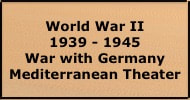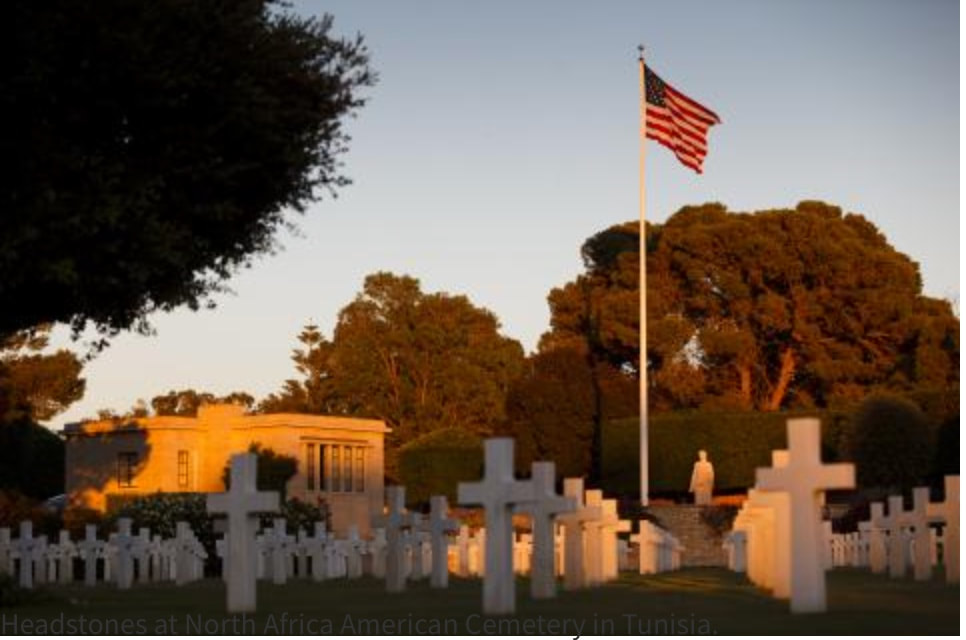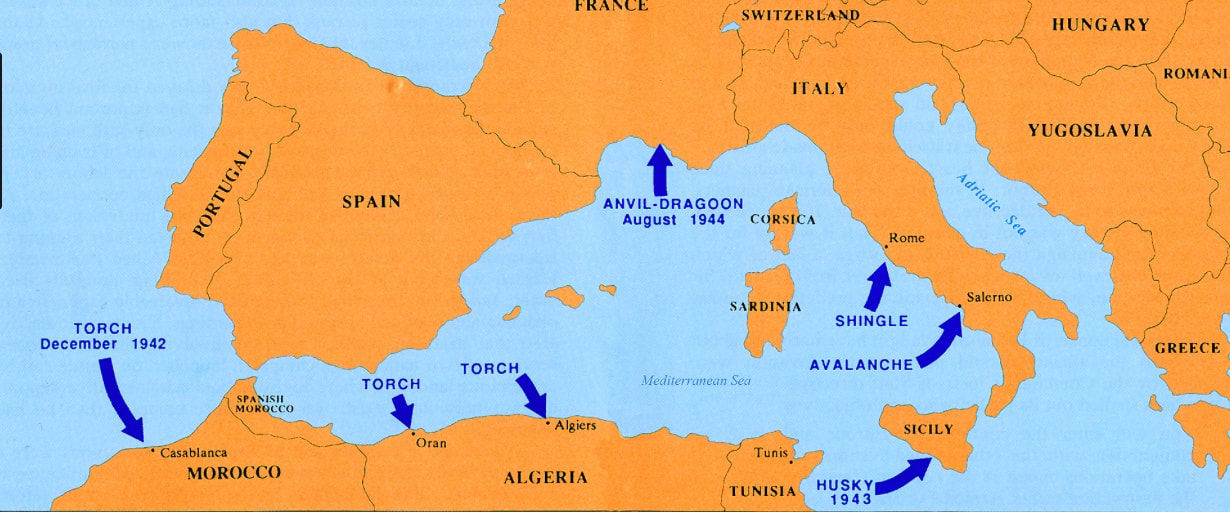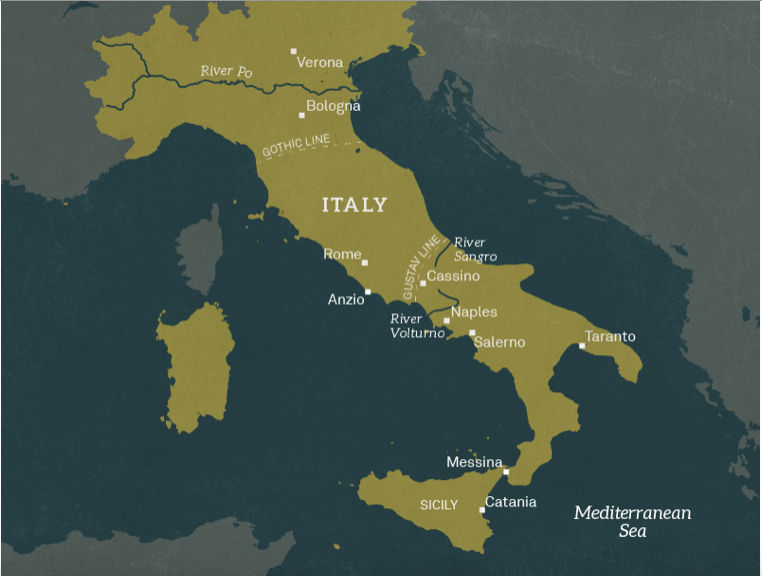The MTO: Background Overview North Africa Italy Air War Sea War Comm. Zone
bigpigeon.us webpage WWII Germany > The MTO, © 2024 by Robert A. Christiansen, updated by RAC 13 Jul 2024.
World War II's Mediterranean Theater of Operations - the MTO - mainly consisted of North Africa and Italy.
US ground combat in the Mediterranean Theater began with Allied landings in northwest Africa on 8 Nov 1942 and ended with the surrender of Axis forces in northern Italy effective 2 May 1945.
bigpigeon.us webpage WWII Germany > The MTO, © 2024 by Robert A. Christiansen, updated by RAC 13 Jul 2024.
World War II's Mediterranean Theater of Operations - the MTO - mainly consisted of North Africa and Italy.
US ground combat in the Mediterranean Theater began with Allied landings in northwest Africa on 8 Nov 1942 and ended with the surrender of Axis forces in northern Italy effective 2 May 1945.
Links to all of Big Pigeon's WWII Germany > The MTO webpages:
The MTO - Background - WWII in the Mediterranean area before November 1942
The MTO - Overview - ground campaigns in the Mediterranean area starting in November 1942
The North Africa Campaigns
The MTO - Background - WWII in the Mediterranean area before November 1942
The MTO - Overview - ground campaigns in the Mediterranean area starting in November 1942
The North Africa Campaigns
- North Africa - Order of Battle
- Operation Torch (Nov '42)
- The Race to Tunis (Nov '42)
- Tunisia (Nov '42–May '43)
- Italy - Order of Battle
- Sicily (Jul–Aug '43)
- Italy Leaves the Axis (Jul–Oct '43)
- Salerno-Naples-Foggia (Sep–Oct '43)
- Naples to Rome (Oct '43–Jun '44)
- + The Volturno Line (Oct–Nov '43)
- + The Bernhardt Line (Nov '43–Jan '44)
- + Battle of Anzio (Jan–May '44)
- + The Gustav Line/Cassino #1 (Jan–Feb '44)
- + Cassino #2 and #3 (Feb–Mar '44)
- + Cassino to Rome (May–Jun '44)
- Rome to Florence (Jun–Sep '44)
- The Northern Apennines (Sep '44–Apr '45)
- + Northern Apennines Fall 1944
- + Northern Apennines Winter 1944–45
- The Po Valley (Apr–May '45)
- The MTO Air War
- The MTO Sea War
- The MTO Communications Zone
- MTO means Mediterranean Theater of Operations, which for United States ground forces consisted of Morocco, Algeria, Tunisia, and Italy.
- Some webpages are currently incomplete.
United States Army official list of MTO campaigns:
- Algeria–French Morocco Campaign, 8 November 1942–11 November 1942 - Allied victory over Vichy French.
- Tunisia Campaign, 17 November 1942–13 May 1943 - Allied victory; Axis forces captured.
- Sicily Campaign, 9 July–17 August 1943 - Allied victory; Germans retreat into mainland Italy.
- Naples–Foggia Campaign, 9 September 1943–21 January 1944 - stalemate; Germans conduct a fighting withdrawal to the Gustav Line.
- Anzio Campaign, 22 January–24 May 1944 - stalemate at first; Allies fail to capture Rome, Germans fail to destroy Allied beachhead; Allies break out from the beachhead several months later.
- Rome–Arno Campaign - 22 January–9 September 1944, Allied victory; Germans withdraw to the Gothic Line.
- North Apennines Campaign -10 September 1944–4 April 1945, stalemate.
- Po Valley Campaign, 5 April–2 May 1945 - Allied victory; Germans surrender in Italy.
The Allied Armies in the Mediterranean Theater, 1942-45
For North Africa:
For North Africa:
- British First Army, Algeria & Tunisia, November 1942 - May 1943 (General Kenneth Anderson)
- British Eighth Army, Egypt, Libya & Tunisia, August 1942 - May 1943 (General Bernard Montgomery)
- US Seventh Army (General George Patton)
- British Eighth Army (General Bernard Montgomery)
- US Fifth Army (General Mark Clark until December 1944, then General Lucian Truscott)
- British Eighth Army (General Bernard Montgomery until December 1943, then General Oliver Leese until October 1944, then General Richard McCreery)
Mediterranean Theater Executive Summary
(See The MTO - Overview for a fuller treatment.)
|
North Africa:
|
|
Italy:
|
██ Sources for Big Pigeon's WWII Germany > The MTO webpage ██
- The webpage header image, North Africa Cemetery, by Warrick Page, https://twitter.com/usabmc/status/1362497662683996160/photo/1 - c/o of the American Battle Monuments Commission (ABMC). This cemetery is near Tunis. The ABMC has two other Mediterranean Theater cemeteries, near Anzio, Italy and near Florence, Italy.
- The United States Army official list of MTO campaigns data, https://en.wikipedia.org/wiki/List_of_United_States_Army_campaigns_during_World_War_II.
- The US Landings in the Mediterranean map, excerpted from https://history.army.mil/brochures/ike/Ike-6a.jpg - Dwight David Eisenhower, CMH #71-40, https://history.army.mil/brochures/ike/ike.htm.
- The Mediterranean Theater - Italy map, www.nam.ac.uk/explore/italian-campaign - c/o Great Britain's National Army Museum, https://www.nam.ac.uk.




